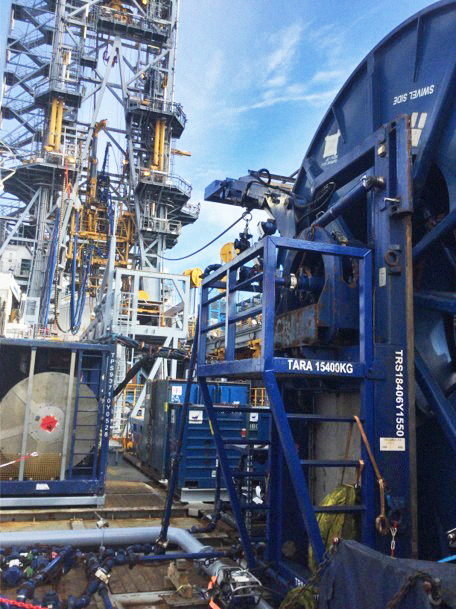Delivers power for downhole tools, enabling more efficient and battery-free intervention operations.
First live well CT intervention from a monohull vessel in the Norwegian Continental Shelf
A North Sea operator successfully conducted nine subsea well interventions without infrastructure, overcoming challenges related to space constraints and extreme vessel movement. This multiyear campaign marked the first live well CT intervention—and the first deployment of ACTive™ powered downhole measurements system—for subsea wells from a monohull vessel in the Norwegian Continental Shelf (NCS).
There are thousands of subsea wells in the North Sea without platform structures due to the water depth. While this reduces environmental footprint, it also presents unique challenges for well intervention operations. An operator needed to perform CT interventions for three wells in the NCS with no infrastructure and no place to take well returns. The operator did not want to use any drilling rigs, instead opting to perform well interventions from an existing monohull vessel. The vessel was already engaged in riserless interventions, but the operator’s planned subsea interventions required a versatile riser solution capable of operating efficiently in water depths ranging from 200 to 500 m.
The operator faced two key challenges: space constraints and extreme vessel movement caused by wave heights exceeding 3 m. The monohull rig’s small footprint restricted the size and amount of equipment that could be used, including well control and intervention systems. In addition, with some waves predicted to exceed operating limits, the operator needed to mitigate CT pipe damage caused by vessel heave.
This campaign marked the first CT live well interventions from a monohull vessel in the NCS. Together with the vessel supplier and operator, SLB implemented an integrated approach involving robust equipment, advanced technologies, and meticulous planning. Key steps included comprehensive equipment integration, physical interface checks to ensure adequate space on the vessel, and the development of a weather-resistant, modular riser handling package, including a custom-built CT tension frame for both CT and wireline operations. This allowed the operator to adapt to different intervention modes within 3h—without cranes, winches, or extensive modifications to the vessel. What’s more, operational efficiencies, including hybrid power supply and innovative pumping solutions, saved 2,700 metric tons of CO2e compared with conventional offshore rig setups.
Despite some waves surpassing operating limits during CT operations, the vessel's novel compensation system and the CT tension frame allowed operations to continue without compromising safety—with zero recordable HSE incidents. The subsea CT interventions met all objectives, including restoring wellbore access and cleaning out solids from production intervals. Over the course of the campaign, through team collaboration between SLB, OneSubsea and Aker Solutions, and procedural improvements, the team reduced time to run the workover riser by 33% and time to stab the CT into the injector head by 75%.
After the success of the initial campaign, the operator collaborated with SLB for two additional intervention campaigns—for a total of nine wells in three years. The operator expanded the annual scope of cleanout work to include subsea wells with ultralow bottomhole pressure. To overcome the challenges of these subhydrostatic well conditions, nitrified-underbalanced and production-assisted cleanout was introduced. SLB deployed the Olga™ dynamic multiphase flow simulator and the ACTive powered downhole measurements system, successfully staying within drawdown requirements, ensuring continued well flow, and setting new benchmarks for subsea well interventions in the North Sea.

For more information, read SPE-212939-MS.
ACTive and Olga are marks of SLB. Other company, product, and service names are the properties of their respective owners.
